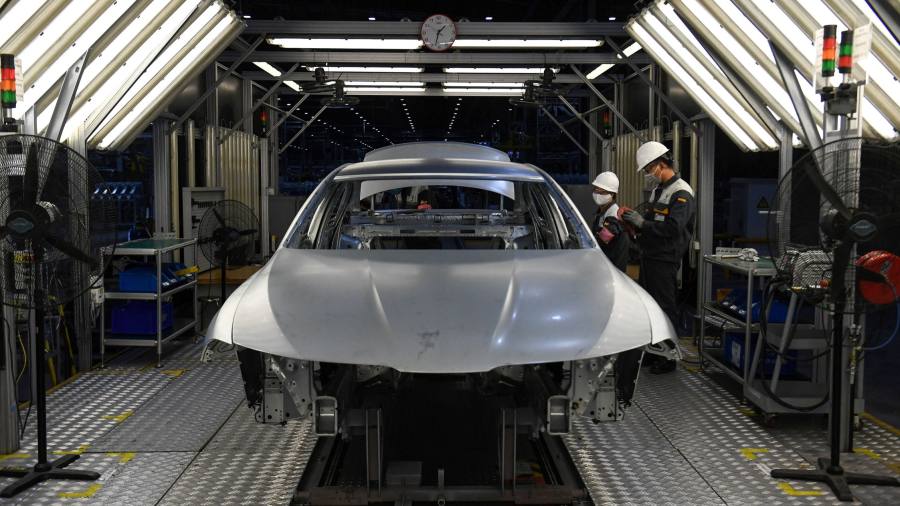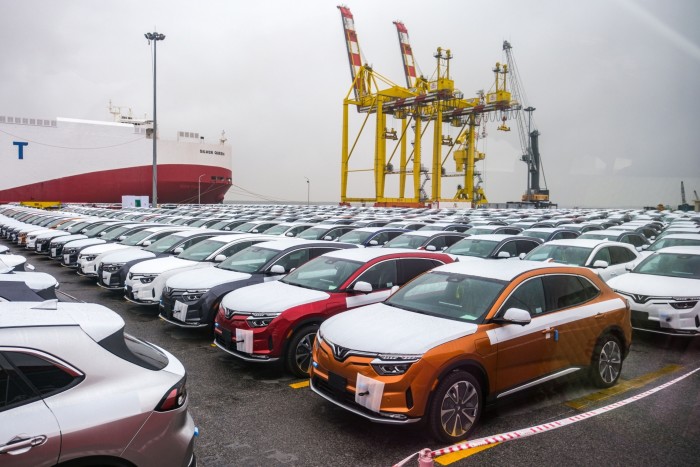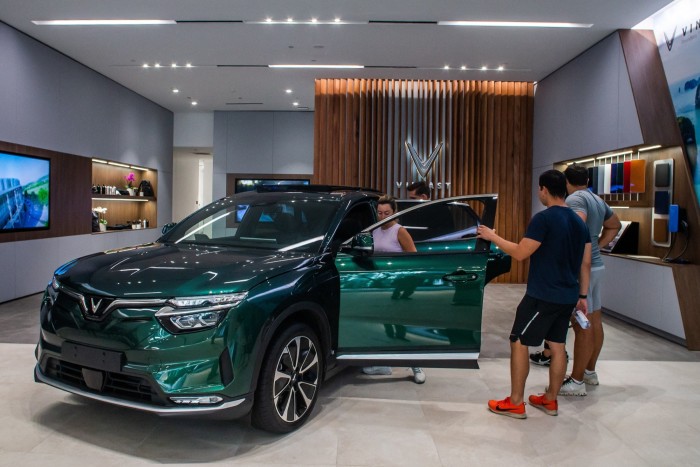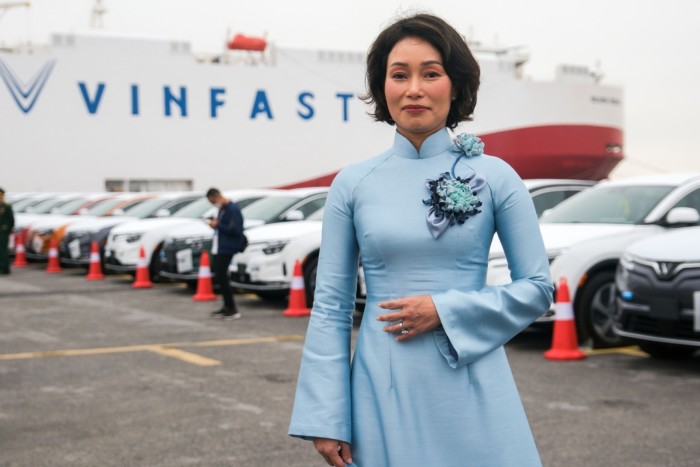
Speed is of the essence at VinFast, the upstart carmaker hoping to become Vietnam’s answer to Tesla.
The company was founded just six years ago, when the site of its auto factory two hours from Hanoi was swampland. Now VinFast says the plant is capable of producing a quarter of a million vehicles a year, while the company is trying to break into the US market and is heading for a New York stock market listing this month.
“The pace VinFast applies to the business is out of this world, the name says it,” says Luis Gustavo Lemes Pereira, a 35-year-old Brazilian engineer who previously worked for companies such as Chery and General Motors, as he shows visitors around the company’s electric vehicle production line.
The ambitions of this inexperienced carmaker, from a country with a limited manufacturing history and relatively small consumer market, underlines how the rapid global shift to electric vehicles is spurring new names to take on brands that have dominated carmaking for decades. VinFast is trying to follow the tracks of Chinese brands such as Warren Buffett-backed BYD, which in just a few years has become the world’s largest maker of electric or plug-in hybrid vehicles — overtaking even Tesla, the industry’s arch-disrupter.
“We think that the EV market is wide open,” VinFast chief executive Le Thi Thu Thuy told the FT in her office in Hanoi. “The whole world is moving to EVs . . . we are not competing for a shrinking market share.” Last year, just three years after selling its first petrol model, VinFast stopped developing petrol-driven cars to focus on EVs.
One senior industry executive who worked directly with VinFast said the company, founded by Vietnam’s richest businessman and politically well-connected, was making “a play on an international scale, supported . . . by the [Vietnamese] government”.

While VinFast has no shortage of grand plans for US growth — it has a network of gleaming showrooms in California and plans to build a factory in North Carolina — its ambitions have faced a reality check.
A first shipment of 999 cars, which arrived in the US last December, received several poor product reviews: the flagship VF 8 model “proves building cars is hard”, Car & Driver magazine said. In May, the first cars shipped were recalled after the US National Highway Traffic Safety Administration warned that a software error in the dashboard display prevented critical safety information from being shown and “may increase the risk of a crash”.
Meanwhile plans for a $23bn NYSE IPO have had to be downgraded. VinFast will now list via a merger with a blank-cheque Spac company on the lower-profile NYSE American exchange, without raising any outside money. Instead founder Pham Nhat Vuong, who controls the homes-to-universities Vingroup conglomerate, is putting in a further $2.5bn of cash, and VinFast shareholders will retain 99 per cent of the shares.
Net losses at VinFast in the first quarter were VND14,120.8bn ($598.3mn) against VND 9,660bn in the same quarter the previous year.
Thuy blamed difficult international market conditions for the shift in listing plans.
“For the last 18 months or two years, we have been working on a traditional IPO, we were pretty much ready to submit [but] the international market, especially the IPO market, has not been ready, the window didn’t really open,” she said.

“I think we anticipate within 18 to 24 months, the capital markets will come back to normal and VinFast will be able to raise funds on its own.”
Meanwhile, she said, “Vingroup and our chair will always support VinFast . . . Whatever VinFast needs, Vingroup always supports.”
One banker working for the business said the onslaught of bad news had dulled the brand’s sheen, making it “increasingly difficult to sell the VinFast story to investors in the US”.
Potential shareholders raised questions including “the quality of the vehicles” and the speed at which the company was trying to launch in the US, the banker said.
Industry specialist Tu Le, founder of automotive advisory and market research firm Sino Auto Insights, said the quality of the vehicles was “persistently panned” in reviews. The feedback showed the company “wasn’t ready for prime time” and needs “another 12-18 months of engineering” in order to be competitive, he said.
Some former employees who witnessed the company’s rapid development first-hand say recent setbacks come as little surprise.

Three former employees who worked in product testing, engineering or homologation on an earlier model said they saw instances of what they considered to be insufficient safety or durability testing to shave time from a vehicle’s development. Another former employee, who has worked at a number of carmakers, said the speed of vehicle development was “frightening”.
A spokesman for VinFast called accusations of corner-cutting a “false allegation”.
He added: “The VinFast VF 8 had successfully passed [US Federal] mandatory safety tests in December 2022, three months before our official deliveries. Before that, we conducted several independent tests for quality, safety, durability, and harsh weather operation . . . with hundreds of vehicles around the world. All of this affirms VinFast’s seriousness and commitment in product development.”
VinFast chief executive Thuy also rejected allegations of taking shortcuts in development.
“We have passed thousands of tests, from our perspective we have not cut any corners,” she said. “However, we are not perfect and our products are not perfect yet. This is our first product. If you talk to people in the industry, our products are not worse than the products in the market, but they are not perfect.”
She said VinFast volunteered the US recall out of “abundance of precaution” for customers. “I think when you deal with software, there are always bugs that you don’t find in testing,” she said.
“What you need to look at is speed of us fixing of our products and how we respond to negative feedback. The speed which we fixed the software is incredible.”
For its global ambitions, VinFast has put in place building blocks to help it gain a toehold in the US market. As well as the planned plant in North Carolina, the company has set up 13 showrooms in prestige locations in California, with the aim of coaxing the state’s wealthy residents away from Tesla.
Its sales centre in Santa Monica, nestled among outlets for Louis Vuitton and Tiffany on an open-air plaza, attracts “lots of footfall” from the nearby beach, according to a sales assistant, who asked to remain anonymous.
The test will come when more beachgoers kick off their flip-flops and get behind the wheel of VinFast’s vehicles.
“It all depends on the product,” said an industry executive at a rival carmaker that supplied parts to VinFast. “If it’s not good enough, you don’t get on the starting grid.”
Additional reporting by Christopher Grimes in Los Angeles